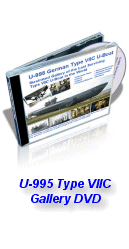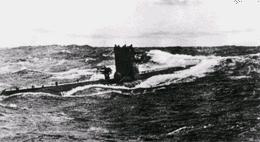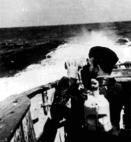

|
U-Boat Surfaced Torpedo Attacks
The greatest advantage of a surfaced attack is speed. A surfaced U-boat is highly maneuverable and faster than many escorts. The U-boat can use its speed to run ahead of the convoy in order to setup an attack position. Speed is also essential when penetrating the convoy’s perimeter, as the U-boat can approach and exploit momentary gaps in the escort screen. Another advantage was that enemy escorts are equipped with sonar, an underwater detection device. But on the surface, a U-boat travels without danger of being detected by sonar.
The approach is best made at night, under the cover of darkness. If possible, the approach is made facing the moon, with the bow or stern pointed as much as possible towards the enemy. This makes it harder for enemy lookouts to spot the U-boat. Later in the war, all this would change as radar removes the invincibility of U-boats during night attacks.

|

|
| A Type VII prowling the Atlantic, searching for prey. | Surface attacks were conducted by the 1WO aboard the bridge. |
For penetration of the perimeter, the ideal position is slightly ahead and on the beam of the convoy. As soon as the escorts have passed, the U-boat can slip into position. This provides the opportunity to attack the convoy broadside with the targets’ angle to bow at about 90 degrees – the optimum firing angle. The optimum firing distance is between 300 to 1,000 meters. Torpedoes require at least 300 meters of run before they arm, so its not possible to attack any closer than 300 meters. The optimum gyro angle of the torpedo is zero degrees. The wider the gyro angle, the higher the chance for error.
Simultaneous targets are ranged and attacked in a single salvo. The most valuable ships in the convoy are placed in the middle of the formation. Those would make the primary targets. In order to maximize the element of surprise, torpedoes are launched at the furthest targets first. This will get the torpedoes to impact at roughly the same time, concealing the element of surprise for a few vital moments more. Large ships may require more than one torpedo hit, but even a single hit will cause the ship to fall out of formation, where it can be picked off later.
Once the torpedo tubes are emptied, the U-boat withdraws using the same way it had used to approach the convoy. This helps conceal the U-boat’s location as the moonlight would be facing its back. If spotted, the U-boat could run at high speeds, before submerging. The torpedo tubes are reloaded (about 10 minutes per tube), and the next phase of attack begins.
Surfaced torpedo attacks are conducted by the First Watch Officer aboard the bridge. He uses the UZO (U-boat targeting optics) aboard the bridge to range and calculate the firing solution. Commands are verbally communicated via a voice tube down to the torpedo crew, who would program and fire the torpedo based on instructions received.
All this time during the engagement, the watch crew are prohibited from witnessing the attack sequence. Four watch crews are on deck, with each covering a 90 degrees arc and they had to strictly scan their respective zones for any activity. They are not allowed to watch the attack to prevent the U-boat from being surprised by a lurking enemy.



